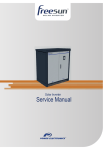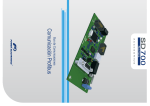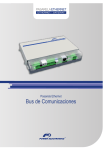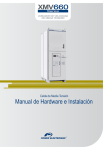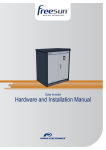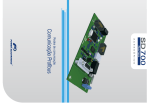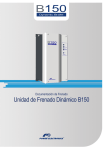Download Service Manual
Transcript
Outdoor Modular Solar Inverter – HEC-UL & HEC-UL+ Series Service Manual Outdoor Modular Solar Inverter – HEC-UL & HEC-UL+ Series Service Manual Edition: August 2014 FSMS05AI Rev. A FREESUN HEC-UL & HEC-UL+ SERIES 2 POWER ELECTRONICS FREESUN HEC-UL & HEC-UL+ SERIES POWER ELECTRONICS SAFETY SYMBOLS Always follow safety instructions to prevent accidents and potential hazards from occurring. WARNING CAUTION This symbol means improper operation may results in serious personal injury or death. Identifies shock hazards under certain conditions. Particular attention should be given because dangerous voltage may be present. Maintenance operation should be done by qualified personnel Identifies potential hazards under certain conditions. Read the message and follow the instructions carefully. Identifies shock hazards under certain conditions. Particular attention should be given because dangerous voltage may be present. Edition of August 2014 This publication could present technical imprecision or misprints. The information here included will be periodically modified and updated, and all those modifications will be incorporated in later editions. To consult the most updated information of this product you might access through our website www.power-electronics.com where the latest version of this manual can be downloaded. SAFETY SYMBOLS 3 FREESUN HEC-UL & HEC-UL+ SERIES POWER ELECTRONICS Revisions Date Revision Description 13 / 08 / 2014 A First Edition The equipment and technical documentation are periodically updated. Power Electronics reserves the right to modify all or part of the contents of this manual without previous notice. 4 POWER ELECTRONICS FREESUN HEC-UL & HEC-UL+ SERIES INDEX IMPORTANT SAFETY INSTRUCTIONS ..................................................................................... 6 1. NOTES ON THIS MANUAL ................................................................................................. 1.1. Scope of Validity .......................................................................................................... 1.2. Target Group ................................................................................................................ 1.3. Documentation ............................................................................................................. 14 14 14 14 2. INTRODUCTION .................................................................................................................. 2.1. Maintenance Tasks in Freesun Inverter ....................................................................... 14 15 3. MAINTENANCE OF THE FREESUN ................................................................................... 3.1. Identifying the Freesun ................................................................................................. 3.2. Reading out Historical Data and Errors ........................................................................ 3.3. Cleaning the Electronic Parts ....................................................................................... 3.4. Cleaning the Protective Grids at the Air Inlets and Outlets........................................... 3.5. Checking the Inside of the Switch Cabinet ................................................................... 3.6. Checking the Power Cable Connections ...................................................................... 3.7. Checking the Safety Notices ........................................................................................ 3.8. Checking the Fans ....................................................................................................... 3.9. Checking Protective Devices........................................................................................ 17 17 17 17 18 19 19 19 19 20 INDEX 5 FREESUN HEC-UL & HEC-UL+ SERIES POWER ELECTRONICS IMPORTANT SAFETY INSTRUCTIONS SAVE THESE INSTRUCTIONS This manual contains important instructions for FREESUN HEC-UL and HEC-UL+ by Power Electronics that shall be followed during installation and maintenance of the solar inverter. IMPORTANT! Read this manual carefully to maximize the performance of this product and to ensure its safe use and installation. In order to properly use the FREESUN inverter, follow all instructions described in the installation manual referred to transport, installation, electrical connection and commissioning of the equipment. Power Electronics accepts no responsibility or liability for any and all damage resulting from inappropriate use of the equipment. The information contained in the installation guide must be observed when installing the inverter. WARNING The Freesun inverter system presents a SHOCK HAZARD. Read and retain the Installation Manual for future reference. Before installing the Freesun inverter, read all instructions, cautionary markings and other appropriate sections of this manual. Failure to follow these warnings could result in severe shock or even death. Exercise extreme caution at all times to prevent possible accidents. These instructions are not meant to cover every safety situation nor replace any local or site specific safety procedure. The information in this section is intended as a supplement to local or site specific procedures. Power Electronics does not assume responsibility for the compliance or noncompliance to any code, national or local for the proper installation of the Freesun inverter. A potential for personal injury and/or equipment damage exists if electrical codes and these instructions are not followed. CAUTION Adhere to local site regulation. Perform all electrical work in accordance with local, national and/or international electrical codes. Use insulate tools to reduce the chance of short-circuits while working with the equipment. Keep all doors closed during equipment operation. Always follow proper lockout/tagout procedures. 6 SAFETY INSTRUCTIONS POWER ELECTRONICS FREESUN HEC-UL & HEC-UL+ SERIES SAFETY STANDARDS The following standards apply to the components: UL-1741 – UL (Underwriters Laboratory) Standard for Safety for Inverters, Converters, Charge Controllers, and Interconnection System Equipment (ISE) for Us in Utility Interactive (grid connected) Power Systems. IEEE-1547. IEEE-519 IEEE Recommended Practices and Requirements for Harmonic Control in Electric Power Systems. NEC (National Electric Code)/NFPA-70E. CSA 22.2 No.107.1-01. CSA 22.1-12. PERSONAL PROTECTION EQUIPMENT (PPE) REQUIREMENTS PPE is required for repair and maintenance of a Freesun inverter. PPE includes but is not limited to: Hard Hat. Safety Glasses. 100% cotton, long pants (no shorts, no synthetic materials). Electrical Hazard (EH) rated safety shoes. Leather work gloves. FR long sleeve shirt, no synthetic materials. Ear protection. Refer to OSHA 29CFR 1910.137 for Personal Protection Equipment (PPE) for working with high voltage electrical equipment. OPERATOR SAFETY CAUTION The inverter operates at a high voltage (1,000Vdc maximum). Do not touch the DC input terminals or cables. Touching the DC terminals may result in personal injury or death. The system has sufficient energy to sustain an arc flash. De-energize the equipment prior to any maintenance procedure. Always wear Personal Protective Equipment (PPE) while maintain equipment that is exposed and energized. Always use insulated tools. Always follow proper lockout/tagout procedures. Operating or maintaining energized equipment without appropriate PPE and insulated tools and without following proper lockout/tagout procedures may result in personal injury or death. SAFETY INSTRUCTIONS 7 FREESUN HEC-UL & HEC-UL+ SERIES POWER ELECTRONICS WARNING Do not remove the protective panels except for periodic inspections or wiring, even if the input power is not applied. Otherwise, you may access the charged circuits and get an electric shock. Do not open the doors while the inverter is working. Otherwise, you may get an electric shock. Do not open the doors when it is raining or when humidity exceeds 95%. Otherwise, you may get an electric shock and the equipment could be damaged. Operate the switches with dry hands. Otherwise, you may get an electric shock. Do not use cables with damaged insulation. Otherwise, you may get an electric shock. Do not subject the cables to abrasions, excessive stress, heavy loads or pinching. Otherwise, you may get an electric shock. CAUTION Install the inverter on a non-flammable surface. Do not place flammable material nearby. Otherwise, fire could occur. Disconnect the input power if the solar inverter gets damaged. Otherwise, it could result in a secondary accident or fire. After the input power is applied or removed, the inverter will remain hot for a couple of minutes. Touching internal hot parts may result in skin burns. Do not apply power to a damaged inverter or to an inverter with parts missing even if the installation is complete. Otherwise, you may get an electric shock. Do not allow lint, paper, wood chips, dust, metallic chips or other foreign matter into the inverter. Otherwise, fire or accident could occur. 8 SAFETY INSTRUCTIONS POWER ELECTRONICS FREESUN HEC-UL & HEC-UL+ SERIES CAUTION SAFETY Before operating the solar inverter, read this manual thoroughly to gain and understanding of the unit. If any doubt exists then please contact POWER ELECTRONICS, (1-415-874-3668) or your nearest agent. Handle the solar inverter with care according to its weight. Install the inverter according to the instructions within this manual. Do not place heavy objects on the inverter. Ensure that the mounting orientation is correct. Do not drop the inverter or subject it to impact. The Freesun inverters contain static sensitive printed circuits boards. Use static safety procedures when handling these boards. Avoid installing the inverter in conditions that differ from those described in the Technical Characteristics section. The cabinet doors must only be opened for commissioning, maintenance and troubleshooting, as well as for data query and parameter setting. The device is equipped with several fans for cooling. To perform any work on the fans is required that the equipment is switched off as explained in the correspondent section. This procedure should be taken into account for commissioning, maintenance and repair work. The device fans and the power unit create significant levels of operating noise. In addition to this, a fault in the device can lead to very high sound levels. We recommend the use of ear protection when in the vicinity of the device for extended periods. Immediately after isolating the device, depending on the operating conditions, certain components can be very hot (e. g. fuses, transformer core, sine wave filter, heatsinks, etc.). Safety gloves should always be worn when working near components that can be expected to be very hot. We recommend using safety gloves and glasses during all work on the inverter. TRIAL RUN Verify all parameters before operating the inverter. Always apply voltage and current signals to each terminal that are within levels indicated in this manual. Otherwise, damage to the inverter may result. OPERATION PRECAUTIONS Do not modify or alter anything within the inverter. SAFETY INSTRUCTIONS 9 FREESUN HEC-UL & HEC-UL+ SERIES POWER ELECTRONICS CAUTION SPECIAL HAZARDS OF PHOTOVOLTAIC SYSTEMS Photovoltaic systems have special characteristics that can represent special hazards: 10 An active power source is connected. This means that, regardless to the operating mode of the inverter, there may be voltage present, either from the photovoltaic generator and/or the FREESUN. This is especially important to consider when disconnecting particular parts of the system. Very high DC voltages are present (no zero-crossing) which, in case of a fault or inappropriate use of fuses or plugs, may lead to arcing. The short-circuit current of the photovoltaic generator is dependent on the level of solar irradiation and only slightly more than the maximum operating current. A highly branched generator array may be difficult to disconnect if a fault develops (e. g. short circuit). We recommend the extra use of an external DC disconnect and fuses for disconnecting the inverter to meet the requirements of NEC 690. These components are included in the Power electronics optional disconnecting unit. Fuses should be allocated to each DC input of the FREESUN inverter as it is required by NEC 690. Power Electronics covers this requirement with the Disconnecting Unit included in HEC-UL and HEC-UL+ Series inverters. The Freesun HEC-UL+ integrates the Disconnecting Unit in the same inverter’s cabinet and the Freesun HEC-UL integrates it in an annexed cabinet. Power Electronics must be informed about the grid operator requirements. The device contains capacitors on the AC and DC sides. The discharge time of the capacitors is 5 minutes. Wait until the capacitors have been discharged before carrying out any maintenance task. SAFETY INSTRUCTIONS POWER ELECTRONICS FREESUN HEC-UL & HEC-UL+ SERIES INTEGRATED ELECTRICAL SAFETY FEATURES Freesun inverters have the following integrated electrical safety features: Software protection controls (See section 3.3 and the Programming and Software manual). On/Off switch (Reference 1 of the figure 0.1). DC Disconnect Switch (Reference 3 of the figure 0.1). AC Circuit breaker (Reference 2 of the figure 0.1). Anti-islanding protection (See the Programming and Software Manual). LED/Front panel display when unit is operational. SYSTEM REPAIR AND TROUBLESHOOTING CAUTION Always follow established Lockout/Tagout procedures. Failure to comply can result in serious injury or death to personnel. LOCKOUT / TAGOUT Lockout/tagout standards establish procedures to protect personnel from hazardous energy sources on equipment during service and maintenance. OSHA 29 CFR, part 1910.333 gives flexibility for facility operators to design a lockout/tagout program that suits site specific needs. Lockout/tagout disables equipment producing hazardous amounts of electrical energy allowing servicing and maintenance personnel to safely perform their jobs. Employees must be trained to understand and follow the hazardous energy control procedures. Use only lockout/tagout devices authorized for particular equipment. Lockout/tagout devices must be durable, standardized and substantial. Lockout/tagout tags must identify authorized users to ensure the procedures are strictly adhered to. In order to reduce the chance of inadvertent system energization, the individual identified on the lockout/tagout notices should be the only personnel in possession of keys that can be used to unlock the lockout devices. SAFETY INSTRUCTIONS 11 FREESUN HEC-UL & HEC-UL+ SERIES POWER ELECTRONICS GROUND FAULT WARNING If your installation has the positive or negative pole of the photovoltaic system earth connected, the following instructions must be followed: The only point in the installation where the positive or the negative pole should be grounded is in the inverter (through the Ground Fault Detector Interrupter -GFDI- that is added to that effect). It is important to note that if there was another grounded connection (pole) elsewhere in the installation (in the panels themselves, in the String Supervisor, etc...) the protection provided by the additional GFDI would NOT be effective. Therefore, as part of scheduled maintenance, it is recommended to inspect the insulation between the grounded pole and the earth. This will prevent the GFDI from providing inappropriate protection due to uncontrolled ground leakage. MARKS, SYMBOLS AND CONTROLS ON THE INVERTER CAUTION Do not ignore safety warnings. Failure to follow all safety warnings and caution could result in equipment damage or injury to personnel. Inverter CAUTION labels are listed in the following table: TEXT LOCATION Utility interactive CAUTION - Risk of electric shock. Normally grounded conductors may be ungrounded and energized when a ground-fault is indicated. AC SWITCH Rainproof CAUTION – For Proper Circuit Connection. Connect a minimum ______ kVA rated isolating transformer between the output of the unit and the utility powerline connections. The transformer is to be an isolation type having separate primary and secondary windings. CAUTION – Risk Of Electric Shock. Both AC and DC voltage sources are terminated inside this equipment. Each circuit must be individually disconnected before servicing. When the photovoltaic array is exposed to light, it supplies a DC voltage to this equipment. Use Copper, Copper-Clad Aluminum or Aluminum conductor. WARNING – To maintain safety certification, replace only with the same type and ratings of fuse. CAUTION – Risk of electric shock from energy stored in capacitor. Stop the inverter feeding into the grid and wait 5 minutes before the AC supply disconnection. Do not remove the cover before the AC and DC disconnection. Door. The following symbols can be found in the inverter and used in this manual: DC current AC current Grounding electrode terminal Grounding point inside the inverter On position Off position 12 SAFETY INSTRUCTIONS Front part of each module. AC module cabinet. Door. Rear part of the door. Door. Cable connections. Close to the fuses. Front part of each module. FREESUN HEC-UL & HEC-UL+ SERIES POWER ELECTRONICS The following figure shows the location of the inverter control features: Figure 0.1 Inverter controls Note: For inverters with the AC module located in their left side, the previous image is inverted. Inverter modules switch (Inverter’s ON/OFF switch) Main AC circuit breaker It allows the connection and disconnection of all the inverter modules. It allows the connection and disconnection of the AC grid. Disconnecting unit disconnects (Internal in HEC-UL+ Series or external in HEC-UL) It allows the connection and disconnection of the DC grid. The inside components and distribution must be configured by the user. The following table represents an example of the name plate located on the inverter: Model / Modèle: FS1200CU10R0 DC INPUT / ENTRÉE DC Max. Input DC Voltage / Tension d’entrée DC Max.: 1000V Min. Voltage MPP / Tension MPP Min.: 585V Max. Voltage MPP / Tension MPP Max.: 820V Max. Input DC current / Courant d’entrée DC Max.: 2000A AC OUTPUT / SORTIE AC Nominal output voltage / Tension nominale de sortie: 390V Frequency / Fréquence: 60Hz Nominal Power / Puissance Nominale: 1200kW Max. Output Current / Courant de Sortie Max.: 1776A Ambient Temperature / Température Ambiante: 50ºC NEMA 3R MADE IN SPAIN SAFETY INSTRUCTIONS 13 FREESUN HEC-UL & HEC-UL+ SERIES POWER ELECTRONICS 1. NOTES ON THIS MANUAL 1.1. Scope of Validity This document describes how to maintain the Freesun HEC-UL & HEC-UL+ inverters. It is valid for HEC_V2 versions. 1.2. Target Group This document is for installers and operators of a Freesun. It includes a description of the maintenance of the Freesun, the intervals and the maintenance work. The appropriate maintenance protocol describes the replacement intervals of the components that need to be replaced. 1.3. Documentation The documents listed below are included in the scope of delivery for your Freesun. The following information is contained in these documents. Installation manual: hardware, installation and commissioning manual User CD containing the Hardware and Installation manual, and the Programming and Software manual. 2. INTRODUCTION The Freesun inverter and the Disconnecting Unit must be maintained at regular intervals. Maintenance includes the following activities: Inspection of wearing parts, and replacement if necessary. Functional test of components. Inspection of contact joints. Cleaning of cabinet interior, if necessary. Ambient conditions. The maintenance interval depends on the location and the ambient conditions. A device installed in a dusty environment requires more frequent maintenance than recommended. The maintenance interval is to be adapted accordingly. 14 INTRODUCTION FREESUN HEC-UL & HEC-UL+ SERIES POWER ELECTRONICS Ambient conditions Module ALL Input and output power Power connections Are the ambient temperature and the humidity within specification? Are there any abnormal noises or vibrations? Is the input and output power correct? Are the Power terminals correctly fastened? Conductor/ Cable Fuses LOW VOLTAGE MAIN CIRCUIT IGBT's module Correct capacitor Inductances Transformer AC contactor and circuit breakers Insulation resistance in grounded installations Is there any earth leakage? Is the grounded pole conductor damaged? INSTRUMENT OF MEASUREMENT Thermometer, Temperature: Hygrometer, -4ºF to +122ºF (-20ºC to +50ºC). Datalogger. o Visual and audible. There are no anomalies. o Measure the displayed voltage between terminals L1, L2, L3 and between positive (+) and negative (-) DC poles. o Verify power connections one week after start-up. Annually check that the power Measure the temperature and Infrared connections temperatures are torque of the power thermometer. homogeneous and below 70ºC. connections. Torque key. Check that the bolts are torqued properly as indicated in the manual. Digital multimeter. Tester. Display. Visual check. No anomaly. o Visual check. If the cabinet paint is scratched or removed, it could appear oxide and corrosion. o Replace missing or damaged labels. No anomaly. o Visual check. No anomaly. Visual check. No anomaly. Visual check. Disconnect the output power cables of the inverter and measure the resistance value between: L1,L2,L3 DC(+), DC(-) with a tester > 10k No anomaly. o o o o Check the resistance value between each one of the terminals Have fluid leaks been observed? Is the capacitor well fastened? Is any dilation or retraction sign observed? Measure the capacitance Is there any liquid leak? Is there any overheated point? Check for visual damage. Is there any overheated point? Is the contactor damaged? Are the circuit breakers placed in each module damaged? CRITERION o Check cabinet paint about visual damage or corrosion. Check the safety notices and stickers on and in the switch cabinet. Check the bottom connection metal panels about pools, dust or rubbish. Is the conductor corroded? Is the isolation of the cable damaged? Is there any fuse melted? INSPECTION METHOD External measurement. o Check sealing on the doors. Check doors, gratings and cabinet about visual damages. Cabinet Integrity and cleanness 2 years INSPECTION 3 months PERIOD INSPECTION ELEMENT Weekly INSPECTION SITE 2.1. Maintenance Tasks in Freesun Inverter o Digital multimeter. Analog tester. o Visual check. No anomaly Instrument for Measure the capacitance with Capacitance higher than 85% of measuring a proper instrument. rated capacitance. capacity. o Visual check. Measure the surface and connectors’ temperature. Visual check. Measure the surface and connectors’ temperature. No anomaly. Check that the temperature is homogeneous and below 70ºC. No anomaly. Check that the temperature is homogeneous and below 70ºC. Disconnect the power supply. Reset de circuit breaker with the test button. No anomaly. Disconnect the GFDI fuse. Measure the resistance between the grounded phase and earth. The resistance value is above 1kΩ. o o o o o o Infrared thermometer. Infrared thermometer. Digital multimeter. Analog tester. INTRODUCTION 15 Cooling fans Are there any abnormal noises or oscillations? Is there any overheated module? Inlet and Outlet Are the gratings clogged by Gratings plastics or rubbish? 2 years 3 months INSPECTION INSPECTION METHOD CRITERION o Disconnect the power supply (OFF) and rotate the fans manually. Check the connections. Check IGBT temperature. Fan should rotate effortlessly. No anomaly. o Visual check. No anomaly. Dust filters Are the dust filters obstructed? o Visual check. No anomaly. Measurement Is the voltage and current displayed values correct? o Check the reading instrument with an external measurement. Check the specified values and the control values. o Check that the energy values are correct. Check that there are not errors or they have been solved. No anomaly. DISPLAY COOLING SYSTEM POWER ELECTRONICS PERIOD INSPECTION ELEMENT Weekly INSPECTION SITE FREESUN HEC-UL & HEC-UL+ SERIES Historical data and errors Is the historical data correct? Are there any errors stored? Note: Maintenance interval could be shorter if required by location or ambient conditions. 16 INTRODUCTION INSTRUMENT OF MEASUREMENT Voltage meter / Current meter etc. POWER ELECTRONICS FREESUN HEC-UL & HEC-UL+ SERIES 3. MAINTENANCE OF THE FREESUN 3.1. Identifying the Freesun You can identify the Freesun by using the type label, which is located on the right side of the Freesun. Model / Modèle: FS1200CU10R0 DC INPUT / ENTRÉE DC Max. Input DC Voltage / Tension d’entrée DC Max.: 1000V Min. Voltage MPP / Tension MPP Min.: 585V Max. Voltage MPP / Tension MPP Max.: 820V Max. Input DC current / Courant d’entrée DC Max.: 2000A AC OUTPUT / SORTIE AC Nominal output voltage / Tension nominale de sortie: 390V Frequency / Fréquence: 60Hz Nominal Power / Puissance Nominale: 1200kW Max. Output Current / Courant de Sortie Max.: 1776A Ambient Temperature / Température Ambiante: 50ºC NEMA 3R MADE IN SPAIN 3.2. Reading out Historical Data and Errors A regular check of the plant operation is necessary to recognize possible failures which have no alarm function. Furthermore, plant operation might be improved by analyzing the plant data. Deviations from the optimum operation can result in yield losses and thus in a reduction of the plant's profitability. Depending on the plant size, the error memory of the central inverter as well as the long-term data of the data logger must be analyzed at least once a month. Proceed as described in the user manual. 3.3. Cleaning the Electronics Parts The electronic parts of the Freesun inverters are considerably well-protected and thus require almost no maintenance work. Only carry out a visual inspection and clean the circuit boards with a soft brush or a vacuum cleaner with a soft top part if there are dust deposits. The cleaning equipment must be anti-static and ESD-compliant. Do not use any hard or coarse brushes. Do not use pressurized air. MAINTENANCE OF THE FREESUN 17 FREESUN HEC-UL & HEC-UL+ SERIES POWER ELECTRONICS 3.4. Cleaning the Protective Grids at the Air Inlets and Outlets This section describes how to clean the protective grids at the air inlets and outlets. The inverter module electronics and the AC module are cooled through a cooling system installed in each electronics compartment that moves the fresh and clean air from the bottom, through the dust filters and fans, to the top dust filters and exhaust fans. Each fan presents a cooling capacity of 75m³/h. The dust filters located in the inlet and outlet grating of the cabinet must be cleaned or replaced as part of the regularly scheduled maintenance. The inverter can integrate two types of grating. The frequency of maintenance should be according to the environmental site conditions. To replace the type 1 inlet and outlet filters, follow the next steps: Pull from the top right corner to unclip the grating. Remove and clean/replace the filter. Place again the filter. Clip again the grating pressing smoothly. Figure 3.1 Filter clean/replacement To replace the type 2 inlet and outlet filters, follow the next steps: Unscrew the three bolts that fix the grating to the electronics module. Unscrew the two bolts that fix both parts of the grating. Remove and clean/replace the filter. Place again the filter. Screw again the grating parts. Screw again the grating to the electronics module. Figure 3.2 Filter clean/replacement 18 MAINTENANCE OF THE FREESUN POWER ELECTRONICS FREESUN HEC-UL & HEC-UL+ SERIES 3.5. Checking the Inside of the Switch Cabinet 1. Check the inside of the switch cabinet for heavy dust deposits, dirt, moisture and water penetration from outside. 2. If necessary, clean the Freesun and employ suitable corrective measures. 3.6. Checking the Power Cable Connections 1. Check all power cable connections for looseness and tighten them if necessary. 2. Check the connectors and insulation for discoloration or degradation. 3. If necessary, replace any damaged connectors or corroded contacts. 3.7. Checking the Safety Notices Check the safety notices and stickers on and in the switch cabinet and replace missing or damaged labels. 3.8. Checking the Fans Depending on the switch cabinet model, the following fans are available: Cabinet cooling fan Interior rotating fan(s) Check all cooling fans for functionality and operating noise, while the Freesun is stopped and the doors are opened. You can use the test fan mode in order to check the interior Freesun fans. In order to check the cabinet cooling fan: 1. Ensure that cabinet cooling fan is connected to a control voltage (supply voltage) and is supplied with power. 2. Turn the thermostats down as far down as possible. The fan start running as soon as the value of the set temperature has dropped below the set value. 3. Once the functional test of the fans has been conducted, adjust the thermostats back to the initial setting. The value is specified with an adhesive label on the thumb wheel and in the circuit diagram. MAINTENANCE OF THE FREESUN 19 FREESUN HEC-UL & HEC-UL+ SERIES POWER ELECTRONICS 3.9. Checking protective devices Depending on the switch cabinet model and production version, the central inverters have several circuit breakers which need to be regularly checked for correct function. You can locate the exact position and the number of circuit breakers using the reference designation of the components in the provided circuit diagram. Figure 3.3 FREESUN internal view. Inverter modules rear view (left), front view (center) and AC module (right) NUMBER 1 2 3 4 5 6 7 8 9 10 20 DESCRIPTION Auxiliary circuit Breakers Main module AC circuit breaker Auxiliary control power supply and auxiliary power source circuit breakers Main AC Circuit Breaker AC Module contactor DC contactor Soft charge contactor DC measure protection fuses Main circuit surge arrester and fuses Main auxiliary circuit breaker MAINTENANCE OF THE FREESUN FREESUN HEC-UL & HEC-UL+ SERIES POWER ELECTRONICS 3.9.1. Switch OFF procedure 1. Turn off the AC module switch key by selecting the “OFF” position. The AC contactor (5), the DC circuit breaker (6) of the modules will switch off and the bus discharge process is enabled during 30 seconds. Wait 5 minutes for the bus caps to discharge. 2. Disconnect the main AC circuit breaker (4) using its specific window. 3. Disconnect main DC switch (Disconnecting Unit). Do not leave the inverter DC busbar energized. Use site approved LOTO procedures. 4. Open the inverter’s doors and disconnect Auxiliary circuit breakers (3, 10). CAUTION Voltage present on the DC bus. DC busbars and fuses of the Disconnecting Unit remain connected to the photovoltaic cables. Hazard voltages may be present. The Freesun inverter contains capacitors on the AC and DC sides that must discharge once the device has been switched off. After switching off, there are dangerous accidental-contact voltages present within the device, the discharge time of the capacitors is 5 minutes. 3.9.2. Checking the Main AC Circuit Breaker The main AC circuit breaker is installed in the inverter in such way that it is not possible to touch electric parts. It is also possible to manipulate it by opening the door’s window. Figure 3.4 Main AC circuit breaker MAINTENANCE OF THE FREESUN 21 FREESUN HEC-UL & HEC-UL+ SERIES POWER ELECTRONICS 3.9.3. Checking the DC Fuses and Disconnectors of the Disconnecting Unit The Freesun HEC-UL+ integrates the Disconnecting Unit in the same inverter’s cabinet and the Freesun HEC-UL integrates it in an annexed cabinet. 1. Visually check the existing fuses and tension springs on the fuse holders. 2. Check all power cable connections for looseness and tighten them if necessary. Check the connectors and insulation for discoloration or degradation. Replace any damaged connectors or corroded contacts. 3. Check all string cable connections for looseness and tighten them if necessary. Check the insulation, and the terminals on the assembly as well on the busbar for discoloration or degradation. 4. If necessary, lubricate the contacts. The check of the fuses and disconnectors is completed. 3.9.4. Checking the DC Contactor Each module in the Freesun inverter has a DC contactor on the DC side. 1. Switch the Freesun to "Stop" and open the doors. 2. Ensure that the Freesun is connected to a control voltage (supply voltage) and is supplied with power. 3. Tape door contact switch to the "On" position. 4. Switch the Freesun to "Start". The DC contactor is switched on and shifts to "On" position. 5. Switch the Freesun to "Stop". The DC contactor trips and shifts to "Off" position. 6. Release door contact switches (remove the adhesive tape). 7. Close the cabinet doors. 22 MAINTENANCE OF THE FREESUN FREESUN HEC-UL & HEC-UL+ SERIES POWER ELECTRONICS 3.9.5. Checking the Overvoltage Arrester The central inverters have several overvoltage protectors which need to be regularly checked for correct function. You can locate the exact position and number of overvoltage protectors using the reference designation of the components in the provided circuit diagram. The overvoltage protectors are inspected visually and by means of measurements. 1. Visual inspection of the arrestor for optical signs of wear. 2. Check the operating readiness of the arrester via the function and fault signaling (A) of the protection path which is free of operating current. Visual display green Visual display red Overvoltage protector is ready for operation Overvoltage protector defective 3.9.6. Maintaining the Insulator Monitor The GFDI is subject to aging caused by wear of the contacts every time they are tripped. Due to aging, sensitivity is reduced. Check the insulation of the PV generator in regular maintenance intervals in order to ensure the functionality of the insulator monitor. 1. Visual inspection of the insulator monitor. Remove possible dirt or dust deposits by using a vacuum cleaner or with compressed air. 2. Pulse test mode in order to verify the correct performance of the insulator monitor. The plant operator determines the insulation test of the entire plant. In case the mechanical or optical check is not fulfilled or in accordance with the maintenance protocol, the insulator monitor must be replaced. Replacement is also necessary after at least after 100 ground faults which led to the tripping of the insulator monitor. Maintenance work of the soft grounding is carried out after checking the insulator monitor. Once tripped, manually reset the failure via the button. MAINTENANCE OF THE FREESUN 23 www.powerelectronics.es | www.power-electronics.com 24 Hours Technical Assistance 365 days a year +34 96 136 65 57 HEADQUARTER • VALENCIA • SPAIN C/ Leonardo da Vinci, 24 – 26 • Parque Tecnológico • 46980 – PATERNA • VALENCIA • ESPAÑA Tel. 902 40 20 70 • Tel. (+34) 96 136 65 57 • Fax (+34) 96 131 82 01 BRANCHES BARCELONA • Avda. de la Ferrería, 86-88 • 08110 • MONTCADA I REIXAC Tel. (+34) 96 136 65 57 • Fax (+34) 93 564 47 52 CATALONIA LLEIDA • C/ Terrasa, 13 · Bajo • 25005 • LLEIDA Tel. (+34) 97 372 59 52 • Fax (+34) 97 372 59 52 CANARY LAS PALMAS • C/ Juan de la Cierva, 4 • 35200 • TELDE ISLANDS Tel. (+34) 928 68 26 47 • Fax (+34) 928 68 26 47 VALENCIA • Leonardo da Vinci, 24-26 • Parque tecnológico ● 46980 ● PATERNA Tel. (+34) 96 136 65 57 • Fax (+34) 96 131 82 01 CASTELLÓN • C/ Juan Bautista Poeta • 2º Piso · Puerta 4 • 12006 • CASTELLÓN LEVANT NORTH CENTRE SOUTH Tel. (+34) 96 136 65 57 MURCIA • Pol. Residencial Santa Ana • Avda. Venecia, 17 • 30319 • CARTAGENA Tel. (+34) 96 853 51 94 • Fax (+34) 96 812 66 23 VIZCAYA • Parque de Actividades • Empresariales Asuarán • Edificio Asúa, 1º B • Ctra. Bilbao · Plencia • 48950 • ERANDIO • Tel. (+34) 96 136 65 57 • Fax (+34) 94 431 79 08 MADRID • Avda. Rey Juan Carlos I, 98, 4º C • 28916 • LEGANÉS Tel. (+34) 96 136 65 57 • Fax (+34) 91 687 53 84 SEVILLA • C/Arquitectura, Bloque 6 • Planta 5ª • Módulo 2 • Parque Empresarial Nuevo Torneo • 41015 • SEVILLA Tel. (+34) 95 451 57 73 • Fax (+34) 95 451 57 73 INTERNATIONAL SUBSIDIARIES GERMANY AUSTRALIA BRAZIL CHILE Power Electronics Deutschland GmbH • Dieselstrasse, 77 • D·90441 • NÜRNBERG ● GERMANY Tel. (+49) 911 99 43 99 0 • Fax (+49) 911 99 43 99 8 Power Electronics Australia Pty Ltd • U6, 30-34 Octal St, Yatala, • BRISBANE, QUEENSLAND 4207 • P.O. Box 6022, Yatala DC, Yatala Qld 4207 • AUSTRALIA Tel. (+61) 7 3386 1993 • Fax (+61) 7 3386 1993 Power Electronics Brazil Ltda • Av. Imperatriz Leopoldina, 263 – conjunto 25 • CEP 09770-271 • SÃO BERNARDO DO CAMPO - SP • BRASIL • Tel. (+55) 11 5891 9612 • Tel. (+55) 11 5891 9762 Power Electronics Chile Ltda • Los Productores # 4439 – Huechuraba • SANTIAGO • CHILE Tel. (+56) (2) 244 0308 · 0327 · 0335 • Fax (+56) (2) 244 0395 Oficina Petronila # 246, Casa 19 • ANTOFAGASTA • CHILE Tel. (+56) (55) 793 965 CHINA KOREA INDIA ITALY JAPAN MEXICO MOROCCO NEW ZEALAND UNITED KINGDOM UNITED STATES OF AMERICA Power Electronics Beijing • Room 606, Yiheng Building • No 28 East Road, Beisanhuan • 100013, Chaoyang District • BEIJING • R.P. CHINA Tel. (+86 10) 6437 9197 • Fax (+86 10) 6437 9181 Power Electronics Asia Ltd • 20/F Winbase Centre • 208 Queen’s Road Central • HONG KONG • R.P. CHINA Power Electronics Asia HQ Co • Room #305, SK Hub Primo Building • 953-1, Dokok-dong, Gangnam-gu • 135-270 • SEOUL • KOREA Tel. (+82) 2 3462 4656 • Fax (+82) 2 3462 4657 Power Electronics India • No 25/4, Palaami Center, • New Natham Road (Near Ramakrishna Mutt),• 625014 • MADURAI Tel. (+91) 452 452 2125• Fax (+91) 452 452 2125 Power Electronics Italia Srl • Piazzale Cadorna, 6 • 20123 • MILANO • ITALIA Tel. (+39) 347 39 74 792 Power Electronics Japan KK • Nishi-Shinbashi 2-17-2 • HF Toranomon Bldg. 5F • 105-0003 • Minato-Ku • Tokyo Tel. (+81) 03 6355 8911 • Fax (+81) 03 3436 5465 • Email: [email protected] P.E. Internacional Mexico S de RL • Calle Cerrada de José Vasconcelos, No 9 • Colonia Tlalnepantla Centro • Tlalnepantla de Baz • CP 54000 • ESTADO DE MEXICO Tel. (+52) 55 5390 8818 • Tel. (+52) 55 5390 8363 • Tel. (+52) 55 5390 8195 Power Electronics – Ekoakua • Geea sarl , N°184 Bloc Hay EL.Massira Aït Melloul • 80150 •Agadir • Maroc Tel: +212 5 28 30 88 33 • Mob: (+34) 628 11 76 72 • Email: [email protected] Power Electronics New Zealand Ltd • 12A Opawa Road, Waltham • CHRISTCHURCH 8023 • P.O. Box 1269 CHRISTCHURCH 8140 Tel. (+64 3) 379 98 26 • Fax.(+64 3) 379 98 27 Power Electronics Corp UK Ltd • Well House • 80 Upper Street • Islington • LONDON N1 ONU • UNITED KINGDOM Tel. 00441494370029 • Fax. (+34) 961 318 201 • Email: [email protected] Power Electronics USA Inc. • 505 Montgomery Street, 11th Floor • San Francisco• CA 94111 • UNITED STATES OF AMERICA Tel: (415) 874-3668 • Fax: (415) 874-3001 • Mov: (415) 376-1471 • Email: [email protected] www.power-electronics.com



























